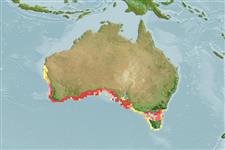Environment: milieu / climate zone / depth range / distribution range
Ekologi
marina revassocierade; djupintervall ? - 30 m (Ref. 9563). Subtropical
Eastern Indian Ocean: Endemic to Australian waters (South Australia and Western Australia).
Size / Vikt / Age
Maturity: Lm ? range ? - ? cm
Max length : 75.0 cm TL hane/ej könsbestämd; (Ref. 9563)
Found on rocky reefs (Ref. 9563). Feeds on various small fish (Ref. 2156).
Life cycle and mating behavior
Maturities | Reproduktion | Spawnings | Egg(s) | Fecundities | Larver
May, J.L. and J.G.H. Maxwell, 1986. Trawl fish from temperate waters of Australia. CSIRO Division of Fisheries Research, Tasmania. 492 p. (Ref. 9563)
IUCN Red List Status (Ref. 130435)
Threat to humans
Harmless
Human uses
Fiskeri: mindre kommeriell
Verktyg
Special reports
Download XML
Internet-källor
Estimates based on models
Preferred temperature (Ref.
123201): 15.3 - 20.5, mean 17.4 °C (based on 183 cells).
Phylogenetic diversity index (Ref.
82804): PD
50 = 1.0000 [Uniqueness, from 0.5 = low to 2.0 = high].
Trofisk nivå (Ref.
69278): 4.5 ±0.80 se; based on food items.
Resiliens (Ref.
120179): Låg, lägsta populationsfördubblingstid 4,5-14 år (Preliminary K or Fecundity.).
Fishing Vulnerability (Ref.
59153): Moderate to high vulnerability (50 of 100).
Nutrients (Ref.
124155): Calcium = 15.4 [8.4, 32.6] mg/100g; Iron = 0.466 [0.232, 0.847] mg/100g; Protein = 19.3 [17.5, 21.1] %; Omega3 = 0.194 [0.109, 0.341] g/100g; Selenium = 14.4 [6.3, 32.3] μg/100g; VitaminA = 92.8 [27.0, 354.4] μg/100g; Zinc = 0.574 [0.363, 0.884] mg/100g (wet weight);
